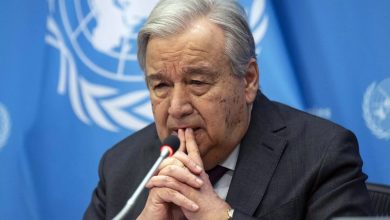Gaza bombing adds to the generations of Palestinians displaced from their homes

An estimated 1.4 million Palestinians have been displaced from their homes since the Israeli military began bombing the Gaza Strip on Oct. 8, 2023, in retaliation for a surprise attack by Hamas militants. Many of these Palestinians have sought refuge in United Nations emergency shelters in a situation the World Health Organization has described as “catastrophic.”
With shelters running out of adequate access to water, food, electricity and other critical supplies, humanitarian agencies are deeply concerned and fear a total breakdown in order.
While the current refugee crisis in Gaza has raised global concern over Palestinian displacement, this is not the first time Palestinians have endured the hardships of forced migration. Long before the latest upheaval, Palestinians who today live in Gaza and throughout the Middle East were forced from or fled their homes in what became the state of Israel. Today, they number about 5.9 million refugees, almost half of the entire global Palestinian population.
Over the past 20 years, my research as an anthropologist has focused on the situation of Palestinian displacement in the Middle East. Having studied some of the daunting challenges millions of Palestinians face as stateless refugees denied the ability to return to their homeland or the right of compensation, I believe it is critical to understand their history and what is at stake for those trapped in indefinite exile.
The majority of Palestinian refugees today receive aid from the United Nations Relief and Works Agency, or UNRWA. Dispersed throughout the region, including in Jordan, Syria, Lebanon and the occupied Palestinian territories, about one-third of all Palestinian refugees live in UNRWA refugee camps, while the remainder live in surrounding cities and towns.
The origins of Palestinian displacement are ongoing and cannot be reduced to a single cause. Most Palestinian refugees, however, can trace their roots to two significant events in Palestinian history: The “Nakba” and the “Naksa.”
The principal event in modern Palestinian history and memory is the Nakba, or what is roughly translated into the “catastrophe.” The term refers to the mass displacement of approximately 700,000 Palestinians during the Arab-Israeli War of 1948 and the creation of the state of Israel.
The majority of Palestine’s Arab population fled their homes during the war, seeking temporary refuge across the Middle East but hoping to return after hostilities ceased.
The mass exodus of Palestinians in 1948 resulted in two realities that have marked the region since. The first involved about 25,000 Palestinians displaced within the boundaries of what became Israel. Known as internally displaced Palestinians, this community did not cross any official border and thus never received refugee status under international law. Instead, they became Israeli citizens, distinguished by their legal designation in Israel as “present absentees.”
Through the Absentee Property Law the Israeli state proceeded to confiscate displaced Palestinians’ properties and deny their right to return to the homes and villages of their birth.
The second event involved over 700,000 Palestinians who fled beyond what became the de facto borders of Israel and acquired formal refugee status under the United Nations. This group of refugees sought shelter in areas of Palestine unconquered by Jewish forces, like Nablus and Jenin, and in neighboring states, including Jordan, Syria, Lebanon and Egypt.
Immediately following their displacement, these Palestinians were subject to ad hoc support from various international organizations until the 1949 creation of the UNRWA, which assumed official responsibility for the management of direct relief operations and refugee camp infrastructure throughout the Middle East.
In addition to providing education, health care and other services, including microfinancing and jobs training, the UNRWA has been supporting refugee camp improvement projects through road construction and home rehabilitation in the camps.
The second-largest displacement of Palestinians occurred in 1967 during the Israel-Arab war known to Palestinians as Al Naksa or the “setback.”
Fought between Israel on one side and Syria, Egypt and Jordan on the other, the war ended with Israel occupying territory in all three countries, including the remaining areas of Palestine: the West Bank and Gaza Strip. During the war, approximately 400,000 Palestinians were displaced from the West Bank and Gaza primarily to Jordan and housed in one of six new UNRWA refugee camps.
Others found refuge in Egypt and Syria. More than a third of those Palestinians displaced in 1967 were already refugees from 1948 and thus suffered a second forced migration. Jus



